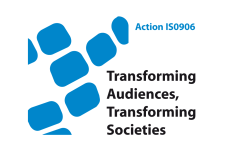- About the Action
- Events
- PhD workshop - Ljubljana 2014
- Action Open Conference - Ljubljana 2014
- New Media and Participation conference - Istanbul 2013
- Belgrade meeting 2013
- Media literacy research and policy - Brussels 2013
- ICA Pre-Conference 2013
- Tampere meeting 2013
- Budapest workshop 2012
- Milan meeting 2012
- Brussels PhD workshop 2012
- Brussels Action workshop 2012
- London meeting 2011
- Zagreb Conference 2011
- Lisbon meeting 2010
- Affiliated events
- WG 1
- WG 2
- WG 3
- WG 4
- Cross-WG
- Output
Call for Participatory Journalism: Possibilities and Constraints for Audience Participation
Medijska istraživanja/Media Research
CALL FOR PAPERS
Special Issue (2013, Vol. 19, No. 2) on:
Participatory Journalism: Possibilities and Constraints for Audience Participation
Editor-in-Chief: Nada Zgrabljic Rotar (University of Zadar, Croatia)
Guest Editor of the Special Issue: Igor Vobic (University of Ljubljana, Slovenia)
COST Action IS0906: ‘Transforming Audiences, Transforming Societies’:
Working Group 2 ‘Audience Interactivity and Participation’.
Aim of the Special Issue:
In late modern societies journalism is shaped by the concepts such as
heterogeneity, fragmentation and individualization. Social networking
sites, blogs, and micro-blogs have recently joined billions of websites
enabling different individual and collective actors scattered across
locales to participate in public communication in a variety of
unprecedented ways. These online forms of communicative engagement have
facilitated the ideas of collaborative and collective in contemporary
journalism of traditional media organizations.
Despite the fact that the idea of participatory journalism engages
people inside and outside newsrooms to communicate not only to, but also
with each other, there have been indications of inclusivist and also
exclusivist principles and practices of news making. On the one hand,
different modes of audience participation in journalism have in some
cases done away with some traditional ideals in journalism, such as
truthiness, principle of objectivity, and disinterest in shaping of
political life, and have replaced them with alternatives, such as
deliberation, multiperspectivity, and participation in political life.
In this sense, ordinary people have with professional-assistance
captured and published in words, photos or videos stories of worldwide
significance and shared personal perspectives or particular views from
their small communities on issues of larger significance reshaping the
dynamics between the global and the (micro-)local in public
communication. On the other hand, traditional media organizations have
developed models of audience engagement that do not involve
non-professionals on equal footing as they enable professional
journalists to retain control in news making. In what appears as
struggle among professionals and non-professionals for legitimacy in
public communication, a clear business motive is often at work – the
pursuit for additional sources of income, the potential to sell targeted
advertising across offline and online media, and getting back now
fragmented mass audience.
Considering the possibilities and constrains for audience participation,
can we speak about the dominant models of participatory journalism or
common modes of audience-engaged news making across locales? How has the
relationship between journalists and the audience changed with the rise
of participatory forms of public communication? How has audience
conceiving among journalists shifted? How has conceiving of journalists
among people changed? How have these dynamics reshaped the prevailing
roles of journalists in society? How has the notion of the audience from
the mass media world transformed? How has social-organization of
traditional media organizations responded and newsroom cultures shifted
in regards to ideas of collective and collaboration embedded in
participatory journalism? How has audience interactivity and
participation re-shaped news discourse of traditional media
institutions? How has news as a cultural product transformed in the
accounts of participatory journalism?
Authors included in this special issue of Medijska istraživanja/Media
Research should consider these questions as the basis of their
theoretical and empirical examinations. It is recommended that the
authors proceed from the particular participatory dynamics in
audience-journalism relationship in their countries, do original
theoretically-informed research study, and then elaborate it in a larger
context of transformations in audience participation. Theoretical
reflections about the issues above, comparative analyses and
methodological reconsiderations are also very welcome.
Important Dates:
Abstracts of 400 words and author’s affiliation with contact details
submission: 1 March 2013
Notification of abstract acceptance: 15 March 2013
Full manuscript of 7000 words submission: 15 June 2013
Results of double blind peer reviews: 1 September 2013
Revised papers submission: 15 September 2013
Notification of acceptance: 15 October 2013
Final papers submission: 1 November 2013
All Submissions should be sent electronically to Igor Vobic(
(igor.vobic@fdv.uni-lj.si)
About Medijska istraživanja/Media Research:
The journal Media Research is abstracted in Sociological Abstracts (SA),
in Linguistic and Language Behavior Abstracts (LLBA) and in Social
Planning/Policy & Development Abstracts (SOPODA), and indexed in Current
Index to Journals in Education (CIJE). Additional information about the
journal, including guidelines for authors, can be found at:
http://hrcak.srce.hr/mediaresearch?lang=en

